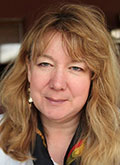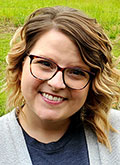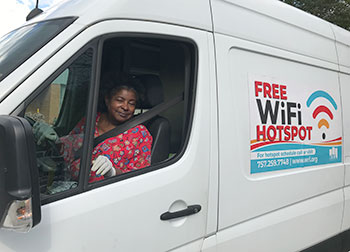
In an April 23 Public Library Association (PLA) webinar, “Public Libraries Respond to COVID-19: Strategies for Advancing Digital Equity Now,” three public librarians shared their experiences with everything from lending laptops and mobile hotspots to low-tech solutions like using sandwich boards and direct mail to advertise library services.
Larra Clark, deputy director of PLA and the American Library Association’s Public Policy and Advocacy Office, moderated the event, joined by Betsy Fowler, director of Williamsburg (Va.) Regional Library; Misty Hawkins, director of Arkansas River Valley Regional Library System; and Julie Walker, state librarian for the Georgia Public Library Service.
As nearly every aspect of our lives moves online, approximately 20 million people still lack home broadband access. But with the COVID-19 pandemic forcing building closures, how are library workers reaching their digitally disconnected patrons to ensure equality?
Clark cited key findings from PLA’s March 2020 survey of 2,545 library workers:
- 93% leave their Wi-Fi on when their building is closed.
- 44% have located Wi-Fi access points to improve access outside library buildings.
- 23% check out mobile hotspots to patrons.
In addition, a small number of libraries are deploying their library vehicles with hotspots to provide community internet access.
Tell us a little about your library and share one or two new programs or services you’ve begun in the last few months to improve internet access during this crisis.
 Betsy Fowler: Williamsburg (Va.) Regional Library serves a population of approximately 90,000—the city of Williamsburg and some very affluent suburbs around it, farming communities, working-class communities, historically disadvantaged communities, and the two counties around Williamsburg.
Betsy Fowler: Williamsburg (Va.) Regional Library serves a population of approximately 90,000—the city of Williamsburg and some very affluent suburbs around it, farming communities, working-class communities, historically disadvantaged communities, and the two counties around Williamsburg.
We have introduced a mobile Wi-Fi community hotspot program using two of our outreach vans. We’ve put two Wi-Fi devices on each one, they have a radius of about 30 feet, and they serve 15 devices each. Working with the schools, we’ve mapped out a schedule of approximately 25 different locations where people were doing community food giveaways, including schools, grocery store parking lots, dollar-store parking lots, and other locations where we felt there was demand.
We’re going out six days a week, and each stop is for two hours. We’ve been building a real usership as we get the word out in a variety of ways to the community.
We also put out a sandwich board and a banner at each stop. Most of the users are sitting in their cars. We have a few on foot, and we put a reminder on the sandwich board to please observe social distancing practices. We have a cell number posted so they can call the driver and ask questions if they need help. We also boosted our Wi-Fi access in our buildings, with outdoor access points, range extenders, and antennas to cover as large an area as possible around the buildings.
 Misty Hawkins: We have seven libraries in the four counties that make up the Arkansas River Valley Regional Library System. That’s approximately 3,000 square miles and a population of 90,000. We are very small and very rural, and luckily, our previous director had already started working on a mobile printing app. We knew that if we were not able to have our doors open, that was going to be a service that we needed to provide using our Wi-Fi. Our patrons are able to print [inside our building] while they’re outside using their laptop or mobile device. Our staffers pass [printouts] through the door, and they never have to come in face-to-face contact with any of our patrons.
Misty Hawkins: We have seven libraries in the four counties that make up the Arkansas River Valley Regional Library System. That’s approximately 3,000 square miles and a population of 90,000. We are very small and very rural, and luckily, our previous director had already started working on a mobile printing app. We knew that if we were not able to have our doors open, that was going to be a service that we needed to provide using our Wi-Fi. Our patrons are able to print [inside our building] while they’re outside using their laptop or mobile device. Our staffers pass [printouts] through the door, and they never have to come in face-to-face contact with any of our patrons.
 Julie Walker: We have 408 public libraries in 159 counties in Georgia. We are a big state with some large rural areas, and a vast number of urban libraries in our large cities as well.
Julie Walker: We have 408 public libraries in 159 counties in Georgia. We are a big state with some large rural areas, and a vast number of urban libraries in our large cities as well.
My agency is a unit of the University System of Georgia. That’s a unique position for a state library, and it does come with a lot of advantages. We were keenly aware of the plight of the 333,000 college students on our 26 public campuses who moved to online instruction in mid-March, as did our K–12 schools.
Because we work closely with our state legislature and other state agencies to address broadband issues in Georgia, we knew it would be difficult for our students to complete online coursework. We worked with our libraries to make sure their Wi-Fi would be accessible outside their buildings, and we gave grants to about 70 that did not have the technology ready to offer that service.
Now, 400 of our libraries offer Wi-Fi access outside the building; most of them do not require a password. We published a map (bit.ly/GeorgiaWiFi) of all libraries so people could locate the library nearest to them that was offering this service. And when you click on a location, you get a link to sign up for an electronic card.
We also worked with the governor’s office, the Georgia Technology Authority, and the Department of Community Affairs to contribute our locations to a larger map of public Wi-Fi sites.
The other immediate issue we found had to do with the college students who were required to complete online coursework but didn’t have devices and were trying to work on smartphones. We had several libraries across the state that already circulated Chromebook laptops, and we had about 250 in the inventory. We scrambled to purchase every Chromebook we could get our hands on and added about 250 more.

Can each of you talk about how you are making these services visible to your patrons and the community, particularly if they’re not connected, but also for people who may have some online access, even if just through their cellphone?
Walker: We are using social media as much as we possibly can. We created a “Library Everywhere” page on our website where we’ve curated all the information. We are sharing it with our K–12 schools, our colleges, other state agencies. I’ve done newspaper and television interviews; we had a front-page story in The Atlanta Journal-Constitution about the first student who got a Chromebook, which was really exciting, and it also touched on our Wi-Fi access as well.
Hawkins: We’re small, we’re rural, and we take to the radio station and the newspaper probably just as much as we do social media because we have to reach such a large space, and people don’t have internet. Arkansas is ranked 48 out of 50 states in internet connectivity.
We made yard signs that say library wi-fi zone—no password required and placed them at every library branch. That was very simple, and it was cost-effective, and we just needed people to know. Also, word of mouth has been great.
Fowler: We’ve thrown the net out pretty wide. We’re using the library windows as giant bulletin boards, so we’re blowing up big posters with all the information if people are around the buildings. We had great coverage from the TV station in Norfolk, big newspaper stories.
But then we were really looking at how we could reach the communities that needed it most, which probably weren’t reading the newspaper or looking at social media or our web page. And we have several different ways—the local bus service gave us free advertising space, so we are advertising in all 20 buses that are circulating through the region right now. We are sending targeted postcards to every address in specific neighborhoods because we found that that kind of direct mailing is very effective. The school foundation offered to pay the postage.
The Williamsburg Health Foundation helped us print thousands of fliers to go in all the food distribution bags that are going out in the community. And we are also leaning heavily on our community partnerships with the jurisdictions, with all the nonprofits, to help get the word out as well.
I don’t think we have really questioned whether people have a library card or not. They’ll have a library card after this, I can guarantee it. Misty Hawkins, director of Arkansas River Valley Regional Library System
Talk a little bit about your partners and collaborators. Any best practices? What have you had to do to make it happen?
Walker: We have been working with several other state agencies, particularly on our big, statewide Wi-Fi map, and they are really helping us get the word out. We’ve always partnered with our public radio stations, which is another wonderful way we’re getting the word out.
We had a strong strategic partnership unit in our agency for a long time, where we offer passes to our state parks, to Zoo Atlanta, to some of our professional sports teams, to a lot of museums, so we are working with them on some virtual museum tours and virtual experiences for students. We already had those relationships in place, so we didn’t have to build those from the ground up.
We also sit on a lot of our statewide literary committees with our Department of Education and our Department of Early Care and Learning, so those built-in relationships have helped us to quickly determine what the needs of those students and teachers are.
And then of course there’s our parent agency, the University System of Georgia. Just being integrated in that has really made us super-aware of the needs and how we can play a part in meeting those.
Hawkins: Each branch manager has been doing a fantastic job reaching out in their individual community and trying to assess the needs. But I will say, at a regional level, we wouldn’t have Wi-Fi to publicize if we didn’t have E-Rate. Because a year ago, without fiber internet connectivity, our branches didn’t have that [high-speed broadband]. Without E-Rate, and without our partners at our state library, it wouldn’t have been possible.
Fowler: Our Friends of the Library were the initial purchasers of the Wi-Fi, and they have stood behind us in our outreach efforts. We have a great web of nonprofits and cooperative arrangements with a lot of groups.
Because we were also spearheading the Complete Count Committee locally for the census, we made a lot of new contacts, especially with local churches. We built up this huge email list of local pastors and other trusted community leaders, and we’re using that as well in this effort.
What are you doing in your outreach, your materials, or anything online for folks who may not have English as their first language?
Hawkins: All our signage is translated into Spanish because of our demographics in two of our counties. Anything we produce on our front doors or in the newspaper, we partner with our local literacy council to translate that for us.
Walker: Our libraries do the same thing. We do have a lot of Spanish speakers in Georgia, and so many of our libraries are very good at making sure their websites and all their fliers and handouts are in multiple languages as well. That’s a big benefit of being with the university system.
Fowler: One county that our HR department falls under allows staffers who have special language skills to take a test, and if they score high enough, they get a slight bump in their pay to do translations for the library. So we have two staff members who can translate all our fliers and materials. And we also have a very vibrant Literacy for Life organization, which has been comprehensive in working with immigrant populations and new arrivals in the community to get the word out.
Are programs and services widely available to anyone, or do they need a current library card?
Hawkins: We now have an option for an online library card application, but at this time, I don’t think we have really questioned whether people have a library card or not. This isn’t the time; they’ll have a library card after this, I can guarantee it.
Fowler: We don’t have a password; there’s no restrictions to accessing the Wi-Fi. We’re really pushing our digital materials and resources and have been investing heavily in them. We wanted to make sure there were no barriers to access.


